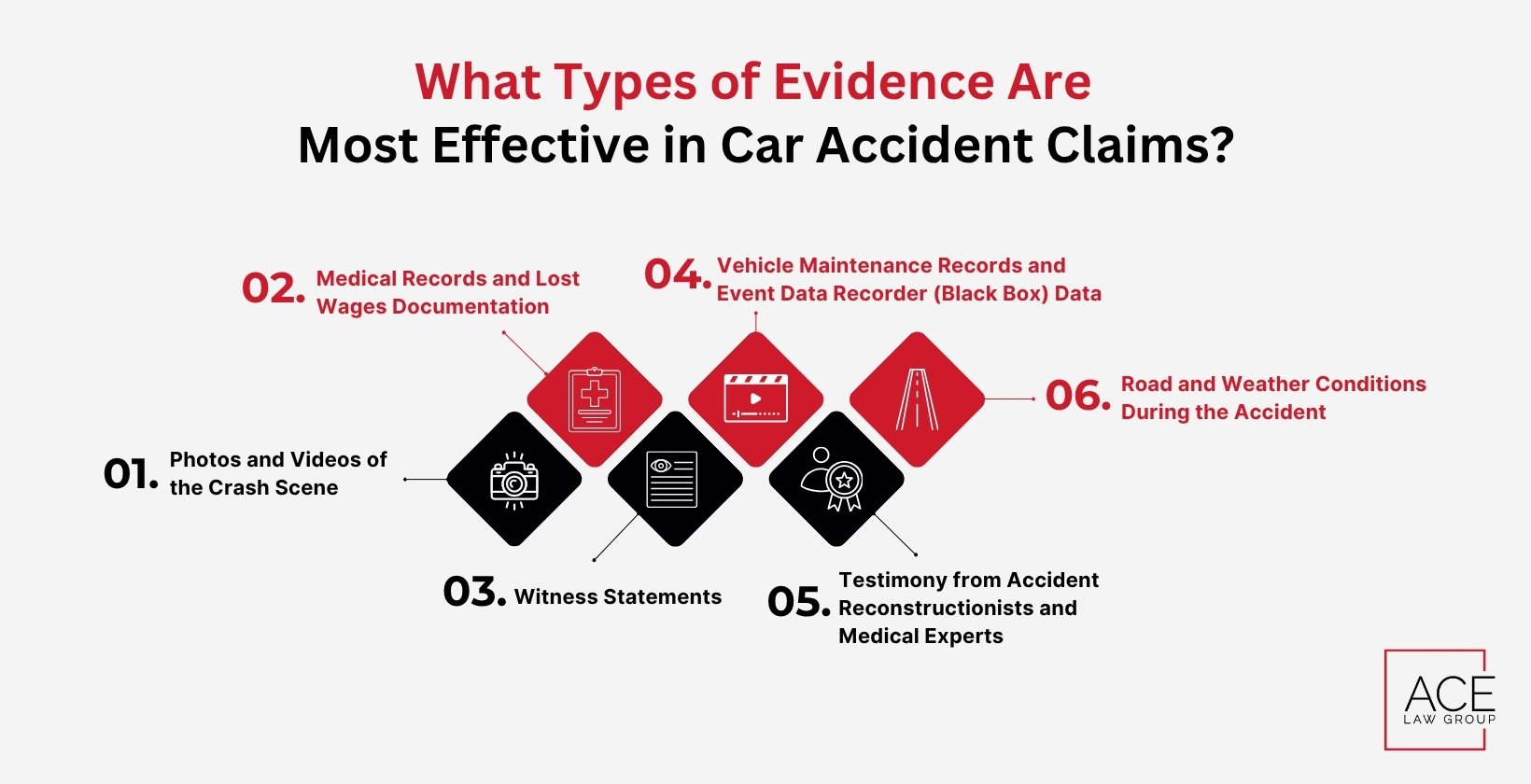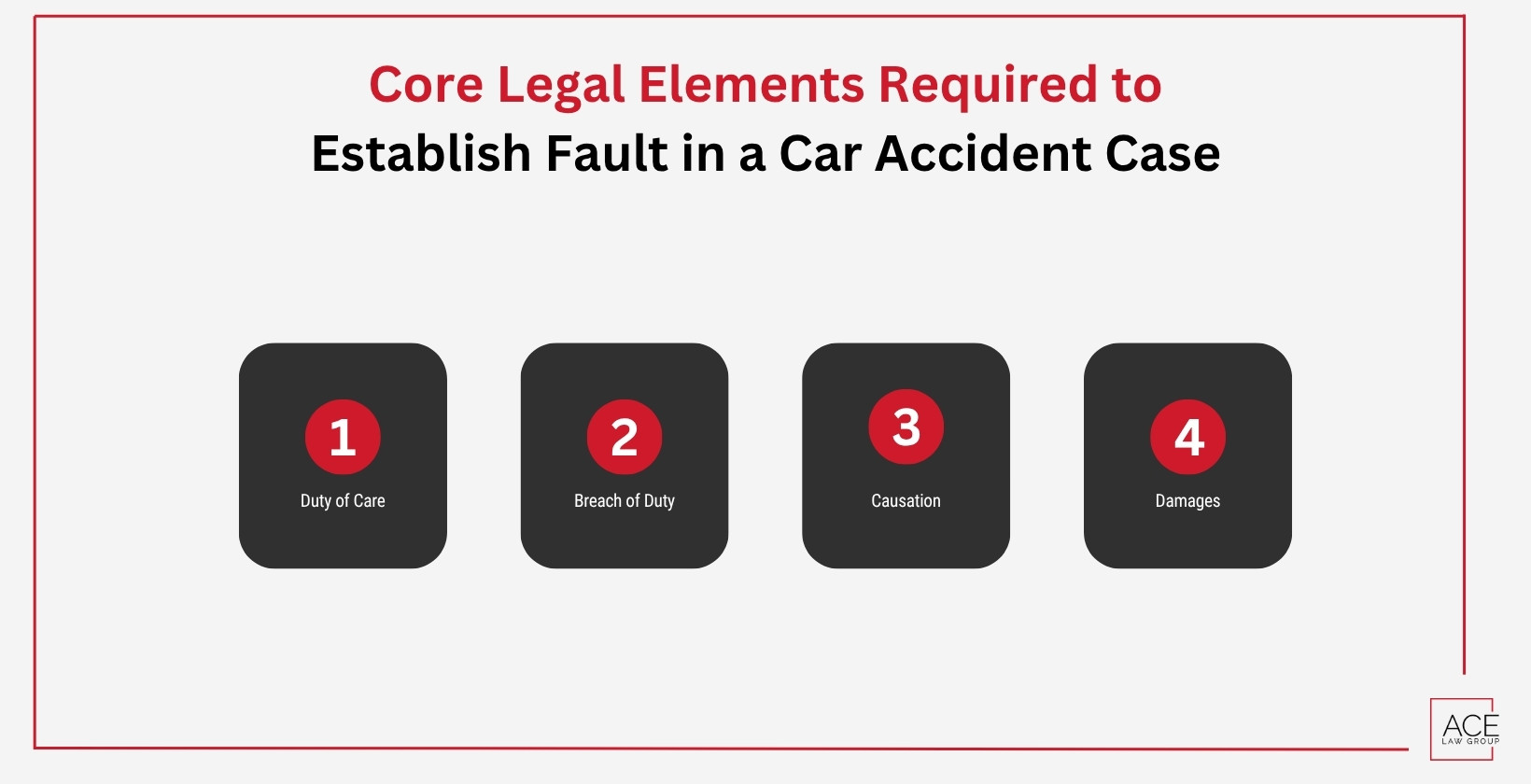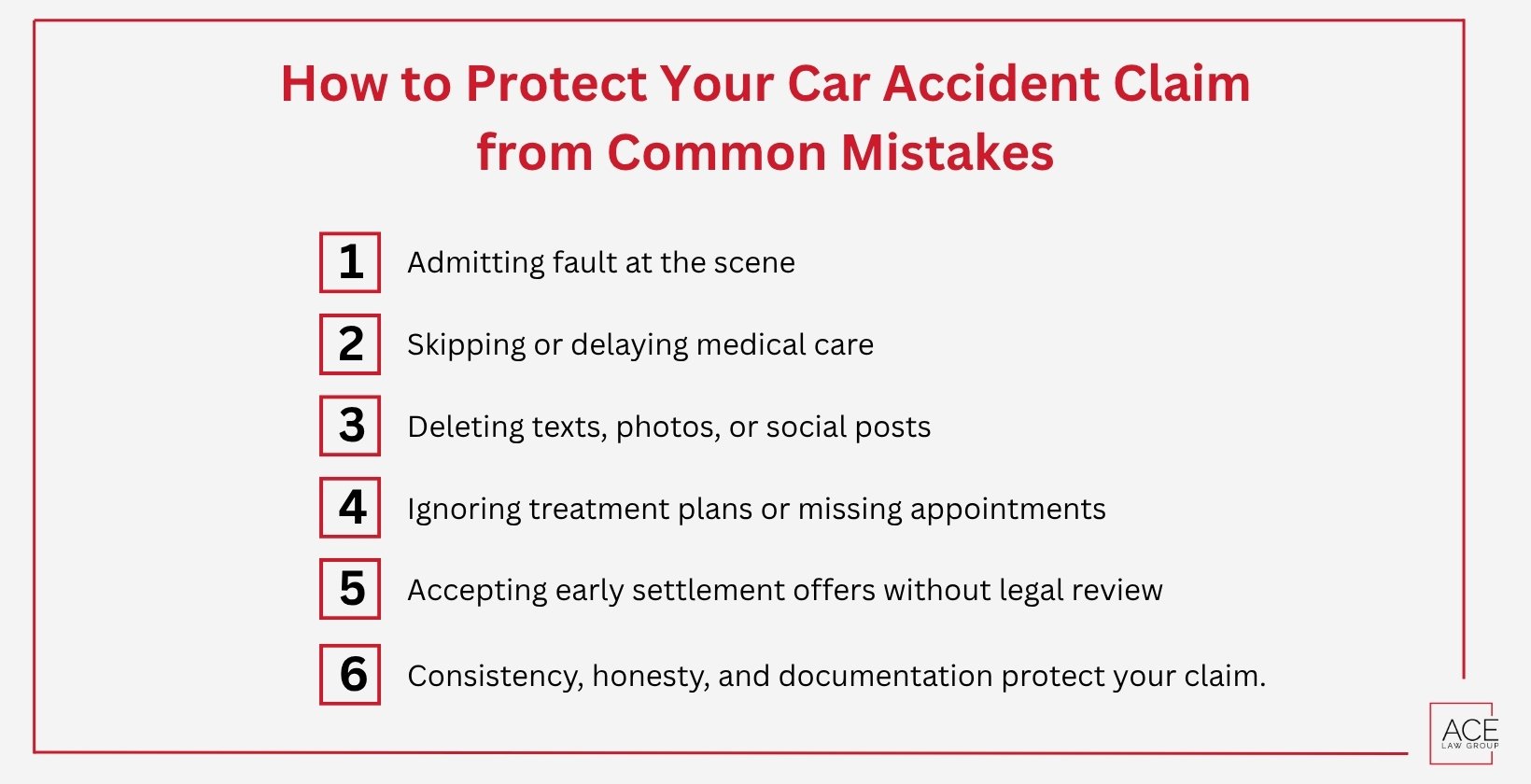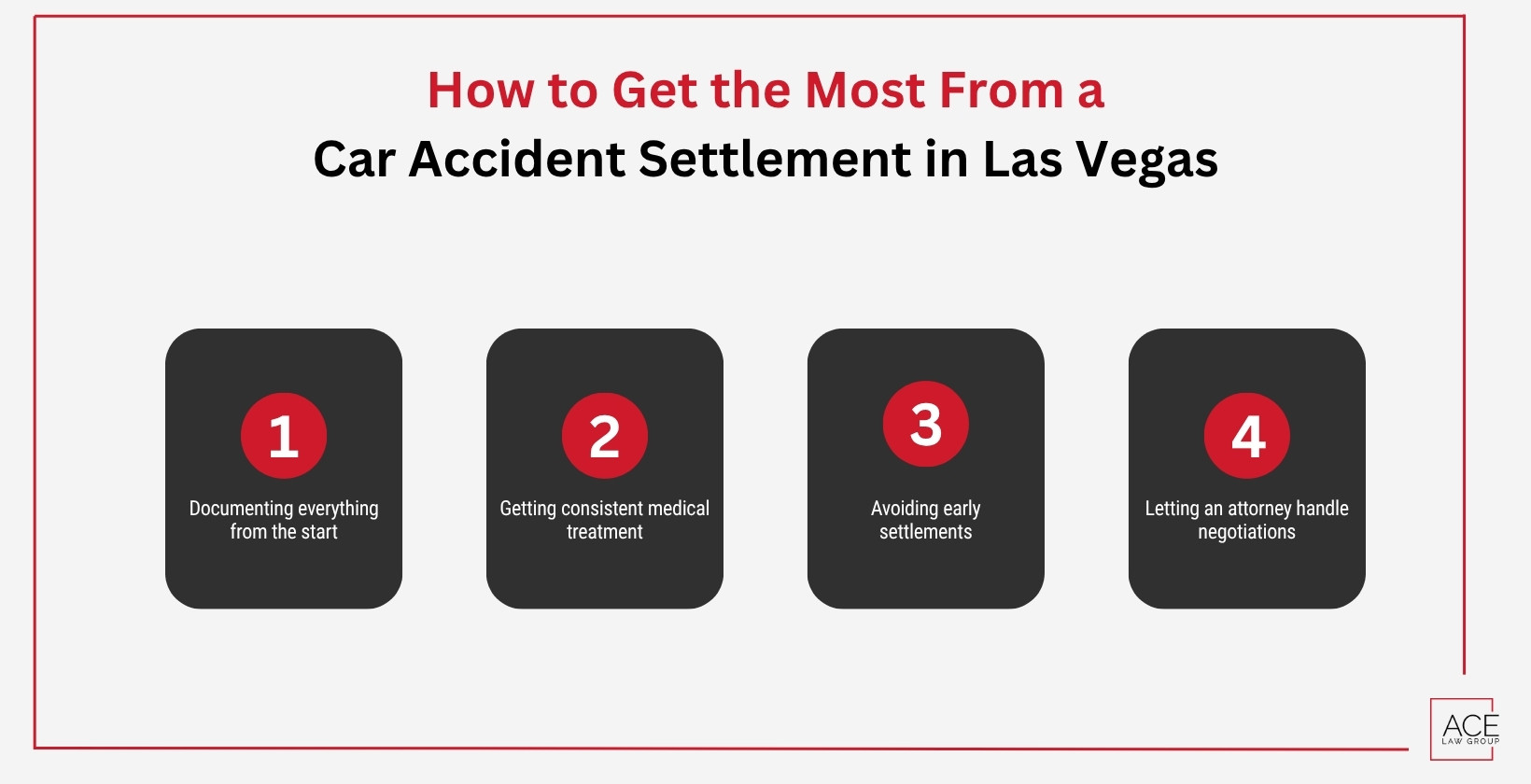Your compensation after a traffic accident in Las Vegas depends largely on the quality and credibility of the evidence you present. As the injured party, you carry the burden of proof, which means you must objectively show how the crash happened and how it caused your injuries and losses.
Legally, car accident evidence refers to any physical or digital documents, records, and testimony that establish fault, causation, and damages. In practice, it’s what enables your car accident attorney to hold the at-fault party financially and legally accountable for the losses you suffered.
Insurance companies and Nevada courts closely evaluate these facts and proof. Weak or incomplete evidence can reduce your payout or derail your claim entirely, which is why it’s fundamental to understand the types of evidence that are most persuasive and how they matter.
Recent Case Result
We secured a $4.8 Million settlement for a client injured in a car crash.
Our legal team fought to recover full compensation for medical expenses, lost wages, and pain and suffering.
Call Us Now: (702) 333-4223What Types of Evidence Are Most Effective in Car Accident Claims?
Successful car accident claims rely on multiple pieces of verifiable evidence presented together to establish a direct link between the incident and incurred damages.
Effective evidence falls into several key categories: visual, medical, testimonial, technical, and environmental. Each of which plays a specific role in showing what happened, who was responsible, and how seriously the victim was affected.
Below, we break down the most impactful types of evidence used in car accident claims.
Photos and Videos of the Crash Scene
Crash scene photos and videos capture the physical aftermath in real-time, including:
- All vehicle damage (from multiple angles)
- Visible injuries to drivers and passengers
- Road conditions, skid marks
- Traffic lights, signs, and weather visibility
Smartphone footage and dashcam recordings often reveal details missed in police reports. These early timestamped proofs help establish fault, prove impact severity, and preserve details that get lost when the scene is cleared.
Medical Records and Lost Wages Documentation
Medical records connect your injuries directly to the accident outcome. Treatment reports prove the seriousness of your condition and justify the care you received. Key medical documents include:
- ER reports and hospital admission/discharge summaries
- Imaging results (X-rays, MRIs, CT scans)
- Treatment plans and physician notes
- Prescriptions and physical therapy records
A strong injury claim requires not just showing you were injured but proving how it affected your ability to work. To prove lost wages, victims need employment verification, including letters from HR, doctor-issued work restrictions, and recent pay stubs.
Witness Statements
Credible eyewitness testimony backs up your claim by adding a neutral, third-party account of the crash. Bystanders with no personal interest help confirm the timeline and details from an unbiased viewpoint. When collected early, written or recorded statements tend to be more reliable. Your attorney may later use these statements or affidavits to support your version of events during settlement talks or in court.
Vehicle Maintenance Records and Event Data Recorder (Black Box) Data
When mechanical failure or driver negligence is in question, maintenance logs and black box data become the sources that determine liability and whether the crash was avoidable.
Maintenance records may show missed safety recalls and delayed or poor vehicle servicing. The vehicle’s EDR, often called the black box, captures technical data like speed, brake application, steering inputs, or seatbelt use from the moments before the crash. These records help identify factors that contributed to the accident.
Testimony from Accident Reconstructionists and Medical Experts
In complex cases, particularly when liability is contested or when the insurance company challenges your medical diagnosis, expert opinions help clarify the nature and impact of the crash.
Accident reconstruction experts analyze impact angles, debris patterns, and vehicle damage to explain fault. Medical experts (such as orthopedic specialists or neurologists) establish long-term injury effects and treatment needs. Their findings are essential for justifying compensation for surgeries, disability, or ongoing care.
Road and Weather Conditions During the Accident
Environmental conditions, road hazards, and poor weather often contribute to crashes, and in some cases, they can shift liability away from the drivers involved. Important evidence includes:
- Photos of potholes, obscured signs, or faded lane markings
- Documentation of rain, fog, flooding, glare, or ice
- 911 dispatch logs, traffic camera footage, and official weather reports
When relevant, your Las Vegas car crash attorney may use this documentation to show how external conditions contributed to the crash or to argue that a third party failed to address known hazards in time to prevent it.

Why Is Evidence the Foundation of Your Car Accident Claim?
The importance of evidence in car accident claims is often irrefutable since it proves liability, injury, economic loss, and non-economic damages. Without clear documentation, insurers and courts have no obligation to accept your version of events or compensate your damages.
In Nevada, solid evidence determines liability under fault-based laws and directly impacts how much you can recover.
How Evidence Determines Liability in a Car Accident Claim?
The question of who’s at fault is based on the quality, relevance, and credibility of evidence that fault laws approve. Evidence determines liability by laying out the facts that show the at-fault party was negligent and proving that their negligence directly caused the accident and the resulting damages.
Both insurance adjusters and courts rely on documented evidence to reconstruct the events of the crash and assign responsibility. Without solid proof, a claim often becomes a “your word against theirs” situation, which rarely favors the injured party.
How Evidence Affects Settlement Amounts?
Eventually, how well your evidence proves injury severity, expenses, and long-term impact determines the value of your car accident settlement.
Evidence directly provides the documentation needed to calculate and justify your complete losses.
Evidence strengthens your negotiation position by:
- Establishing liability
- Proving the severity of the damages
- Justifying economic losses
- Supporting non-economic damages
The more compelling and comprehensive your evidence, the more leverage you have during negotiations, leading to a potentially higher settlement offer.
Who Bears the Burden of Proof in Nevada Car Accident Cases?
In Nevada car accident cases, the plaintiff (the person who files the claim) bears the initial burden of proof. To meet the burden of proof, the plaintiff must use evidence to prove the four key elements of negligence:
- Duty of care
- Breach of duty
- Causation
- Damages
This means the victim must provide enough evidence to show that the defendant is more likely than not responsible for the accident and resulting damages.
How Nevada’s Comparative Fault Law (NRS §41.141) Affects Recovery?
Under NRS §41.141, the strength and clarity of your evidence control how much compensation you’re allowed to receive. Nevada’s modified comparative fault rule reduces your recovery based on your percentage of shared fault and eliminates it entirely if you’re found more than 50% responsible for the accident.
This means your ability to recover doesn’t just depend on what happened but on what you can prove. The better your evidence, the less fault you’re likely to be assigned, and the more compensation you preserve.

How Should You Collect and Preserve Evidence After an Accident?
While the moments after a car crash can be overwhelming, what you do in the first minutes, hours, and days directly shapes the strength of your claim. Evidence collection begins at the scene and continues through your medical care and insurance communications, all while projecting future expenses as well.
Here are the most critical steps to preserve the evidence your case will rely on:
On-Scene Steps
On-site facts are the most powerful and often overlooked evidence. If you’re able, prioritize gathering proof before vehicles are moved or the scene is cleared.
Here’s what to do at the scene of a car accident:
- Take photos of vehicle damage, injuries, skid marks, and road signs
- Record videos that show weather conditions, traffic flow, and vehicle positioning
- Collect witness contact details and record their statements
- Call 911 to document emergency services and police reports
- Note visibility issues, road hazards, or anything unusual
The most time-sensitive evidence, like skid marks or debris, often disappears within hours. A dashcam or phone camera can be your best tool at the scene.
Medical Follow-Ups
Your medical records are the proof that links your injuries directly to the crash. Even if injuries seem minor, do not refuse medical treatment after an accident injury or delay follow-ups, as it may weaken your case and give insurers room to argue that your condition isn’t related. Preserve credibility by:
- Visiting a doctor immediately after the accident, even if there are no symptoms
- Following through with all recommended care
- Keeping copies of all treatment plans and expenses
Documentation Practices
Strong claims rely on well-organized and complete records that link your injuries and losses directly to the accident. Remember, verbal testimonies or subjective opinions don’t work. Keep evidence objective, admissible, expert-backed, and strictly related to the crash. Document your evidence by:
- Saving all physical bills, letters, and receipts
- Screenshotting and timestamping employer emails/texts about missed work
- Journaling pain and suffering, and emotional effects
- Backing up digital photos, recordings, and documents
When in doubt, save everything. Preserved evidence gives your lawyer the leverage to challenge delays, denials, or lowball offers.
What To Do If You Can’t Collect Evidence After a Car Collision?
Your claim remains valid even if you were severely injured or unconscious at the time of the crash, which is common in serious accidents. Even without on-site evidence, liability can still be proven using police reports, emergency medical services records, 911 call logs, surveillance footage, and traffic camera data.
Can Your Own Evidence Be Used Against You?
Yes, insurance companies frequently exploit gaps in your evidence to dispute fault and minimize or deny your claim. During the legal discovery process, both sides exchange evidence, and the defense will closely examine everything you submit. They commonly use inconsistencies in treatment, contradictory statements, or pre-existing conditions to argue that your injuries are unrelated to the accident or that your own negligence caused the collision. This makes it critical to present clear and consistent evidence from the outset and avoid common mistakes.
How to Protect Your Car Accident Claim from Common Mistakes?
Some avoidable errors undermine even strong evidence and create space for your own evidence to backfire. To protect your evidence and your personal injury claim, avoid:
- Admitting fault at the scene
- Skipping or delaying medical care
- Deleting texts, photos, or social posts
- Ignoring treatment plans or missing appointments
- Accepting early settlement offers without legal review
- Consistency, honesty, and documentation protect your claim.

Can a Car Accident Lawyer Help If Key Evidence Is Missing or Incomplete?
Yes, a skilled car accident attorney can often recover, recreate, or legally obtain missing evidence. If you have failed to preserve some time-sensitive facts or lost an important document, your lawyer can still build a case using legal tools and strategies, such as:
- Legal Access to Third-Party or Deleted Records: Lawyers can request surveillance from nearby businesses, police departments, or traffic cameras. If requested early, even deleted dashcam footage or store security video may still be retrievable.
- Subpoenas to Retrieve Phone, Camera, or EDR Data: Attorneys can issue subpoenas for phone records, onboard black box data, and images stored on personal or commercial devices. This data helps reconstruct crash dynamics and behavior.
- Expert Use to Reconstruct Missing Events or Injuries: A lawyer collaborates with accident reconstructionists to analyze damage and explain how a crash occurred. They use independent medical experts who link injuries to the crash, even when records are limited or delayed.
- Legal Strategy to Strengthen Partial or Weak Evidence: Lawyers combine multiple small pieces of evidence, like timestamped photos, consistent treatment notes, and testimony, to build a credible, unified claim. A legal narrative often fills gaps that documentation alone can’t cover.
How Long Should You Keep the Car Crash Evidence?
You should keep car crash evidence for at least 2–3 years or until your case is fully resolved and you have received all compensation owed to you. The relevant statute of limitations in Nevada is the absolute minimum you should keep evidence. Avoid discarding your records early, since appeals or disputes can arise after a claim is closed.
How to Get the Most From a Car Accident Settlement in Las Vegas?
Higher settlements come from meticulously documented evidence and smart timing. Maximize a car accident settlement value in Las Vegas by:
- Documenting everything from the start
- Getting consistent medical treatment
- Avoiding early settlements
- Letting an attorney handle negotiations
Insurers respond to organized, credible claims supported by clear proof of injury and loss

What Are the Legal Deadlines for Filing an Auto Accident Claim in Nevada?
Nevada law sets strict statutes of limitations for car accident claims:
- 2 years to file a personal injury claim (NRS §11.190(4)(e))
- 3 years for property damage claims (NRS §11.190(3)(c))
Note: missing these filing time limits or late filing leads to a complete loss of the right to claim compensation.
Car Accident Resources
How to Get Access to a Car Accident Report in Las Vegas?
Car Accident Determining Fault By Location of Damage
Recovering Lost Wages After a Car Accident in Las Vegas
Are Car Accident Insurance Settlements Taxable?
How to Settle a Car Accident Claim Without a Lawyer?
Causes of Car Accidents in Las Vegas
What Happens If You Total a Leased Car in Nevada?
Frequently Asked Questions About Car Accident Claim Evidence
Can security camera footage from nearby businesses be used as car accident evidence?
Yes. Security camera footage from nearby businesses can help establish fault, vehicle movement, or crash timing. Your attorney can request this footage before it’s deleted, often within days.
Do minor injuries still require medical records?
Yes. Even minor injuries need medical documentation to be considered part of your claim. Without records, insurers may argue the injuries weren’t real, serious, or accident-related.
How long does it take to settle a car accident claim?
The time it takes to settle a car accident claim entirely depends on factors like injury severity, disputed fault, and the strength and relevancy of evidence. Claims with clear liability evidence can settle in a few weeks, while cases of shared fault or missing documents may take months or longer.
Is video footage more reliable than witness statements?
Generally, yes, video footage is more objective, timestamped, and harder to dispute than subjective eyewitness accounts. Witness statements can vary or conflict, especially over time, and insurers and courts often give more weight to video recordings or CCTV footage.
What happens if the at-fault driver deletes dashcam footage?
If someone intentionally deletes dashcam footage, including the details of the crash, your attorney may claim spoliation of evidence. Courts can penalize the at-fault party or infer fault based on the missing footage, especially if other evidence suggests wrongdoing.
How to Act If You’re Unsure About What Evidence You Need?
Accidents create panic, and many victims are understandably unsure about what to do at the scene and what evidence matters; that’s completely normal. While it’s best to collect and preserve evidence early, you don’t need to get everything perfect right away.
If you’re uncertain, start with the basics: scene photos, medical records, and witness details. As your case progresses, save everything, even if it seems minor. Seek legal help from Ace Law Group to review what you’ve collected and move forward. Call us at 702-333-4223 to get a free consultation with our car accident lawyers.